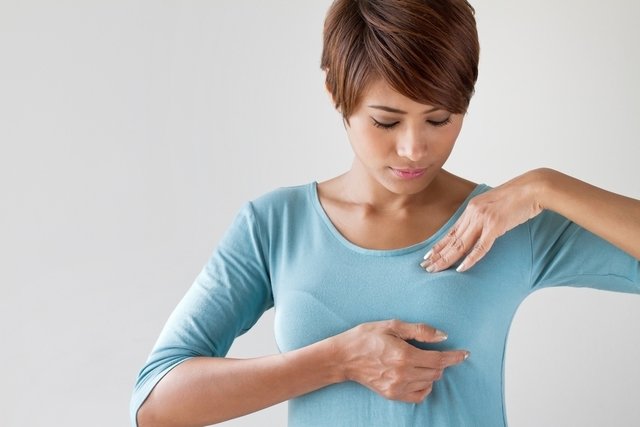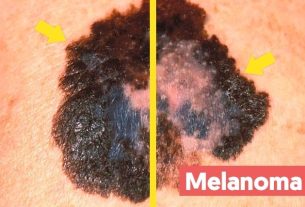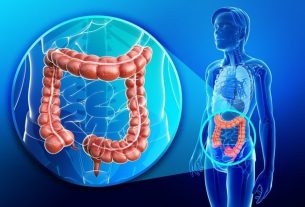Breast cancer is a type of cancer that develops in the breast tissue, and can be identified, at an early stage, through changes in the shape of the breast or nipple, as well as the appearance of a lump in the breast or armpit.
Breast cancer can affect both men and women, but is more common in women, especially when there is a family history of breast cancer, smoking, obesity or excessive alcohol consumption.
If you suspect breast cancer, it is important to consult a general practitioner, mastologist or gynecologist. When treatment is indicated, it can involve anything from the use of medication to surgery and the chances of a cure are greater in the early stages.

Breast cancer symptoms
The main symptoms of breast cancer are:
- Appearance of a lump in the breast or armpit;
- Breast pain;
- Change in the position or shape of the nipple;
- Nipple secretion other than milk;
- Redness in the nipple area;
- Swelling or thickening of the skin over the breast;
- Change in the size or shape of the breast;
- Wound on the breast or nipple.
Breast cancer in its early stages tends to cause no or few symptoms. Therefore, it is important that women carry out regular follow-up with the gynecologist and, when indicated, breast cancer screening through mammography.
Don’t ignore your symptoms!
Male breast cancer
Breast cancer can also occur in men, however it is rare, and symptoms tend to be similar to those seen in women, such as changes in the position or shape of the nipple and the appearance of a lump in the breast. Learn how to identify the symptoms of male cancer.
Possible causes
Breast cancer is caused by mutations in cells that begin to multiply uncontrollably due to genetic and behavioral factors.
The main factors that can contribute to the development of breast cancer are:
1. Age
Age increases the risk of developing breast cancer, with a higher risk for women after the age of 45, and for men after the age of 60.
However, breast cancer can also occur in younger people, especially if they have a family history of breast cancer.
2. History of breast changes
Women who are most likely to develop this type of cancer are those who have already had breast cancer, which increases the risk of developing cancer in the other breast.
The risk is also higher in women who have benign breast changes, such as atypical hyperplasia or lobular carcinoma in-situ and high breast density assessed on a mammogram.
3. Family history of cancer
People with family members who have already had breast or ovarian cancer, especially when a first-degree relative such as a father, mother, sister or daughter, also have a 2 to 3 times higher risk.
In these cases, there is a genetic test to identify mutations in the BRCA1 and BRCA2 genes, which helps to confirm whether there really is a risk of developing the disease, and to carry out medical monitoring more frequently and identify the cancer early.
4. Early menarche
Menarche corresponds to a woman’s first menstruation, which, when it appears early, before the age of 12, increases the risk of developing breast cancer, due to the longer exposure to estrogen throughout life.
5. Menopause
In most cases, menopausal women undergo hormone replacement therapy with drugs composed of estrogen and progesterone, which can increase the risk of developing cancer, especially when they have been used for more than 5 years. However, the risk decreases when hormone replacement therapy is stopped.
Furthermore, late menopause, which occurs after the age of 55, also increases the risk of developing breast cancer, since women are exposed to estrogen for longer throughout their lives.
Furthermore, the risk is also higher in women who use combined hormonal contraceptives.
6. Late pregnancy or no pregnancy
When the first pregnancy occurs after the age of 30 or the woman never has a pregnancy, the risk of developing breast cancer is also greater.
7. Unhealthy lifestyle
As with almost all types of cancer, lack of regular physical activity increases the chances of getting breast cancer, especially due to increased body weight, which favors the development of mutations in cells. Furthermore, lifelong consumption of alcoholic beverages also increases the risk of developing cancer.
8. Previous radiotherapy
Breast laughter also increases in people who have had radiotherapy in the chest region, especially when young, as happens in other types of cancer in this region or in the treatment of Hodgkin’s lymphoma, for example.
9. Unhealthy lifestyle
As with almost all types of cancer, obesity and lack of regular physical activity increase the chances of getting breast cancer in both women and men, especially due to increased body weight, which favors the development of mutations in cells. .
Furthermore, excessive or frequent consumption of alcoholic beverages, or the habit of smoking, also increase the risk of getting cancer.
10. Hormone therapy for prostate cancer
In men, estrogen-containing hormone therapy for prostate cancer may increase the risk of breast cancer.
Additionally, men with a history of cryptorchidism, inflammation in the testicles, removal of the testicles, and some diseases such as Klinefelter syndrome and liver cirrhosis may also increase the risk of breast cancer.
Types of breast cancer
The main types of breast cancer are:
- Carcinoma lobular on site: it is an alteration considered more of a risk factor for the development of cancer than a tumor itself;
- Carcinoma ductal on site: it is a change in breast cells that, if left untreated, usually develops into cancer;
- Invasive ductal carcinoma: it is the most common type of breast cancer;
- Invasive lobular carcinoma: It is the second most common type of breast cancer.
Identification of the type of breast cancer is usually done through a breast biopsy and is useful in indicating the most appropriate treatment.
How to confirm the diagnosis
The diagnosis of breast cancer is made by a general practitioner, gynecologist or breast specialist who may recommend imaging tests, such as mammography, ultrasound or magnetic resonance imaging, and a breast biopsy to confirm the diagnosis. See more details on the tests recommended for breast cancer.
Breast cancer staging
When staging breast cancer, the tumor is classified as T1, when its size is less than 2 cm; T2, when between 2 and 5 cm; T3, when greater than 5 cm; or T4, if there is involvement of the skin or chest wall, for example.
The tumor is also classified according to the involvement of lymph nodes as N1, when it affects axillary lymph nodes, which are mobile and on the same side as the tumor; N2 when these lymph nodes are attached; and N3, when other lymph nodes are affected.
Additionally, when breast cancer arises in other parts of the body, it can also be classified as M1.
While in the early stages breast cancer is small and does not affect other parts of the body, in more advanced stages, the tumor can be difficult to operate on due to its size and involvement of distant organs, vessels and nerves, for example.
How the treatment is carried out
Breast cancer treatment may involve:
1. Surgery for breast cancer
Surgery for breast cancer consists of removing the tumor and may require complete removal of the breast in some cases. Sometimes surgery can be combined with radiotherapy. See the types of surgery to remove breast cancer and when they are indicated.
2. Radiotherapy
Radiotherapy consists of destroying cancer cells using radiation and may be indicated to reduce the size of the tumor before its removal or to eliminate remaining cancer cells after surgery. See how it works and what types of radiotherapy are available.
3. Chemotherapy
Chemotherapy is usually done using drugs capable of eliminating or blocking the growth of tumor cells and can be indicated for a period of 3 to 6 months before or after removal of the tumor by surgery. Understand what chemotherapy is and its side effects.
4. Hormonal therapy
Hormone therapy involves using medications, such as tamoxifen or anastrozole, to stop the growth of tumor cells. It may be indicated in some cases as treatment after removal of the tumor by surgery, to reduce the risk of cancer recurring.
This type of treatment is generally indicated when breast cancer is of the “hormone receptor positive” type, that is, it is sensitive to hormonal drug therapy.
5. Target therapy
Targeted therapy is a type of treatment that uses specific medications, such as trastuzumab, to combat tumor cells and may be indicated in some cases of breast cancer that have specific receptors for these medications.
Is breast cancer curable?
Breast cancer can be cured in some cases, especially when identified in the early stages, when the tumors are small and do not affect other organs or parts of the body.
How to prevent
Key measures to prevent breast cancer include:
- Perform physical exercises regularly;
- Lose weight in case of obesity;
- Avoid excessive alcohol consumption;
- Quit smoking.
Furthermore, in some cases, such as those in which the risk of developing breast cancer is very high, the use of medications, such as tamoxifen or anastrozole, and even preventive removal of the breast through surgery may be indicated.

Sign up for our newsletter and stay up to date with exclusive news
that can transform your routine!
Warning: Undefined array key "title" in /home/storelat/public_html/wp-content/plugins/link-whisper-premium/templates/frontend/related-posts.php on line 12
Warning: Undefined array key "title_tag" in /home/storelat/public_html/wp-content/plugins/link-whisper-premium/templates/frontend/related-posts.php on line 13



